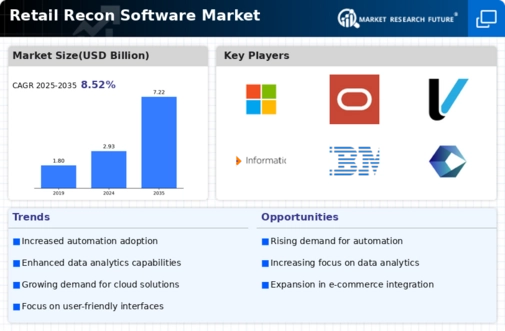Increased Focus on Cost Reduction
Cost reduction remains a pivotal driver in the Retail Recon Software Market. Retailers are under constant pressure to enhance profitability while managing operational costs. The implementation of Retail Recon Software Market can lead to significant savings by automating processes and reducing manual errors. Data suggests that retailers who adopt such software can reduce operational costs by up to 25%. This focus on cost efficiency is likely to propel the adoption of Retail Recon Software Market, as businesses seek to streamline operations and allocate resources more effectively. As the competitive landscape intensifies, the ability to minimize costs while maintaining service quality will be crucial for retailers, further fueling growth in the Retail Recon Software Market.
Integration of Advanced Analytics
The integration of advanced analytics into the Retail Recon Software Market is transforming how retailers operate. Retailers are increasingly leveraging data analytics to gain insights into consumer behavior, sales trends, and inventory turnover. This shift towards data-driven decision-making is evident, as studies indicate that retailers utilizing analytics experience a 15 to 20% increase in sales. By employing Retail Recon Software Market that incorporates advanced analytics, businesses can optimize their pricing strategies and enhance promotional effectiveness. This trend not only improves operational efficiency but also fosters a more personalized shopping experience for consumers. As the demand for data-driven insights continues to rise, the Retail Recon Software Market is likely to expand significantly.
Growing Emphasis on Omnichannel Retailing
The Retail Recon Software Market is witnessing a growing emphasis on omnichannel retailing, which necessitates seamless integration across various sales channels. Retailers are increasingly adopting strategies that unify online and offline experiences, thereby enhancing customer engagement. This trend is supported by data indicating that omnichannel customers tend to spend 30% more than single-channel customers. Retail Recon Software Market plays a crucial role in enabling retailers to synchronize inventory and sales data across platforms, ensuring a cohesive shopping experience. As businesses strive to meet the expectations of modern consumers, the demand for Retail Recon Software Market that supports omnichannel strategies is expected to rise, driving growth in the market.
Regulatory Compliance and Risk Management
The Retail Recon Software Market is increasingly influenced by the need for regulatory compliance and effective risk management. Retailers face a myriad of regulations concerning data protection, financial reporting, and inventory management. The implementation of Retail Recon Software Market can assist businesses in adhering to these regulations by providing accurate reporting and audit trails. As compliance becomes more stringent, the demand for software solutions that facilitate adherence to legal requirements is likely to grow. Furthermore, effective risk management strategies enabled by Retail Recon Software Market can help retailers mitigate potential losses and enhance operational resilience. This focus on compliance and risk management is expected to drive growth within the Retail Recon Software Market.
Rising Demand for Inventory Management Solutions
The Retail Recon Software Market experiences a notable surge in demand for effective inventory management solutions. Retailers are increasingly recognizing the necessity of maintaining optimal stock levels to enhance customer satisfaction and minimize losses. According to recent data, approximately 70% of retailers report that inventory management directly impacts their profitability. This trend is likely driven by the need for real-time visibility into stock levels, which Retail Recon Software Market can provide. As retailers strive to streamline operations and reduce excess inventory, the adoption of sophisticated software solutions becomes imperative. Consequently, the Retail Recon Software Market is poised for growth as businesses seek to implement systems that facilitate accurate tracking and management of inventory.


















Leave a Comment